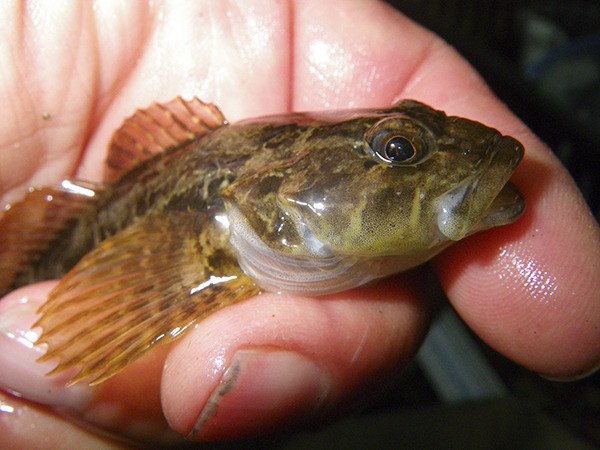Pacific salmon and trout are not the only native fish seen in the San Juan Islands’ healthier streams. One of the most widespread and abundant resident fish of the islands is the inconspicuous Reticulate Sculpin (Cottus perplexus).
Reticulates are unlikely to be seen even by the most persistent sport fishers. They are patchy brown, perfectly camouflaged as they hug pebbles on the stream bottom. They avoid swimming, and rarely rise to bait or flies. Generally less than four inches long, they do not flee from the moving shadow of a human or other predator on the water, but prefer to remain perfectly still until actually touched.
Unlike salmon and trout, Reticulates remain in fresh water their entire lives, only eating what they can find hidden in the gravel: aquatic insects such as caddisfly larvae in their “homes” constructed of bits of leaves, wood and sand; lentil sized Fingernail Clams; tiny freshwater snails; and freshwater crustaceans that are cousins of familiar “sowbugs” and “sand fleas”. It seems that they rarely eat other fish or fish eggs, although they might affect young salmon or trout by competing for the same insect prey.
Male Recticulate Sculpins scoop out nests in the gravel beneath submerged rocks or logs. Female Reticulates loiter in the territories of male fish in early spring, pestering them until they mate. Several females may spray their eggs on the roof of a single males’ underwater hideaway. Males guard the eggs until they hatch.
Young Reticulates grow slowly and may take four years to reach a length of 2.5 inches. By comparison, a young Chinook salmon attains the same size in a few months. Reticulates are also shy and tend to avoid other fish, abandoning choice stream habitats for less favorable ones where other species are present.
Reticulate Sculpins are unique to the Pacific Northwest. They have only been seen in coastal streams between the California-Oregon border and the central Salish Sea. Skagit and San Juan counties form the northern limit of their range. Even within this limited geographic area, the distribution of Reticulates is patchy and unpredictable.
Reticulates tolerate relatively warm, brackish water, so they can live near the mouths of small streams as well as cooler upstream riffles. This may be a clue to their origins. Reticulates are only found in a geographic area that was close to the edge of the last great continental glaciers. Melting ice would have diluted the salinity of the waters along our coasts, and facilitated migration and adaptation of freshwater fish that could survive in slightly salty conditions—such as Reticulates. Reticulates probably colonized the islands’ streams long before the Salish Sea was as salty as it is today!



